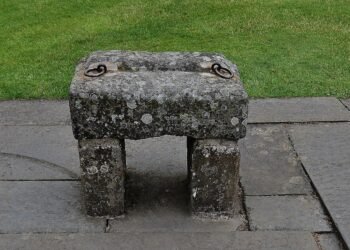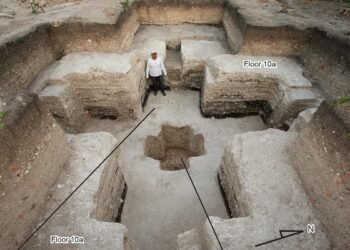National Trust archaeologists have unearthed a 600-year-old Christmas token near Oxburgh Hall in Norfolk. The token, dating between 1470 and 1560, is believed to have originated from Bury St Edmunds Abbey in Suffolk, nearly 30 miles away.
The token was likely distributed by a choirboy acting as the “Boy Bishop” during the Christmas period. The Boy Bishop tradition, prevalent in medieval and early Tudor times, involved choosing a choirboy to parody the adult bishop on the Feast Day of St Nicholas, celebrated on December 6. The chosen choirboy would lead religious services, processions, and collect funds for the church, distributing tokens to the poor.
Angus Wainwright, an archaeologist with the National Trust, explained, “We believe that one of the inhabitants from Oxborough village must have made the long trip to Bury St Edmunds to see the festive ceremonies in the massive Abbey Church, where they may have acquired the token.”
The token, made of lead, had equivalent sizes to a penny, halfpenny, and groat. Its well-preserved side depicts a long cross, reminiscent of contemporary coins, while the reverse side, though corroded, would likely have shown the head of a bishop representing St Nicholas.
Wainwright elaborated on the significance of the find, stating, “This discovery shows how rich the cultural life of even the poorest folk could be in the Middle Ages. It’s also interesting that the Christmas period was a time for fun and celebration aimed at children, with a child taking on the role of the bishop, and St Nicholas as the patron saint of children.”
The archaeological survey in West Park at Oxburgh not only revealed the token but also unveiled part of a medieval village, complete with horseshoes, handmade nails, and tools. Additionally, traces of a Roman village were discovered.
“Although tokens could be spent in the local town, they may also have been kept as keepsakes, but the one we have found could also simply have been dropped and lost,” added Wainwright.
The journey of a resident from Oxborough village to Bury St Edmunds, approximately 27 miles away, reflects the lengths people went to partake in festive ceremonies at the massive Abbey Church. The abbey, once among the largest buildings in Western Europe, would have provided a mind-blowing experience for someone from a tiny village.
As Saints’ days gradually disappeared following the 16th-century Reformation, the tradition of Boy Bishops and the Feast Day of St Nicholas waned. However, the cultural legacy endured, evolving into the modern figure of Santa Claus.
The token, though not a thing of particular beauty, offers a captivating story of medieval Christmas traditions and is currently on display at Oxburgh Hall, a country house built in 1482 by the Bedingfeld family as a statement of power and prestige. The family endured generations of persecution for their Catholic faith.






















